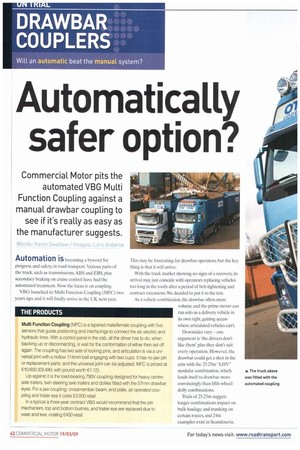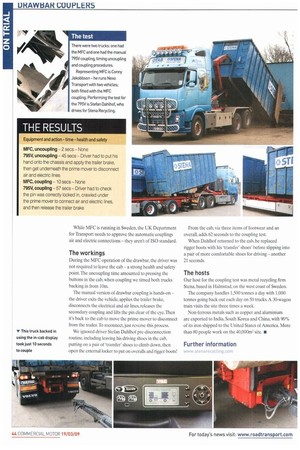Automatically safer option?
Page 42

Page 44

If you've noticed an error in this article please click here to report it so we can fix it.
Commercial Motor pits the automated VBG Multi Function Coupling against a manual drawbar coupling to see if it's really as easy as the manufacturer suggests.
Words: Kevin Swallow / darve Automation is becoming a byword for progress, and safety, in road transport. Various parts of the truck, such as transmissions, ABS and EBS, plus secondary braking on cruise control have had the automated treatment. Now the focus is on coupling.
VBG launched its Multi Function Coupling (MFC) two years ago, and it will finally arrive in the UK next year. This may be frustrating for drawbar operators. but the key thing is that it will arrive.
With the truck market showing no signs of a recovery, its arrival may just coincide with operators replacing vehicles too long in the tooth after a period of belt-tightening and contract extensions. We decided to put it to the test.
As a vehicle combination, the drawbar offers more volume, and the prime mover can run solo as a delivery vehicle in its own right, gaining access where articulated vehicles can't.
Downsides vary one argument is 'the drivers don't like them' plus they don't suit every operation. However, the drawbar could get a shot in the arm with the 25.25m "LHV" modular combination, which lends itself to drawbar more convincingly than fifth-wheel/ dolly combinations.
Trials of 25.25m suggest longer combinations impact on bulk haulage and trunking on certain routes, and 24m examples exist in Scandinavia.
While MFC is running in Sweden, the UK Department for Transport needs to approve the automatic couplings air and electric connections they aren't of ISO standard.
The workings
During the MFC operation of the drawbar, the driver was not required to leave the cab a strong health and safety point. The uncoupling time amounted to pressing the buttons in the cab. when coupling we timed both trucks backing in from 10m.
The manual version of drawbar coupling is hands-on the driver exits the vehicle, applies the trailer brake, disconnects the electrical and air lines, releases the secondary coupling and lifts the pin clear of the eye. Then it's back to the cab to move the prime mover to disconnect from the trailer.To reconnect, just reverse this process.
We ignored driver Stefan Dahlhof pre-disconnection routine, including leaving his driving shoes in the cab, putting on a pair of 'transfer' shoes to climb down, then open the external locker to put on overalls and rigger boots! From the cab, via three items of footwear and an overall, adds 62 seconds to the coupling test.
When Dahlhof returned to the cab, he replaced rigger boots with his 'transfer' shoes' before slipping into a pair of more comfortable shoes for driving another 21 seconds.
The hosts Our host for the coupling test was metal recycling firm Stena. based in Halmstad, on the west coast of Sweden.
The company handles 1,500 tonnes a day with 1,000 tonnes going back out each day on 50 trucks. A 30-wagon train visits the site three times a week.
Non-ferrous metals such as copper and aluminium are exported to India, South Korea and China, with 90% of its iron shipped to the United States of America. More than 80 people work on the 40,000m2 site. •
















































































































































